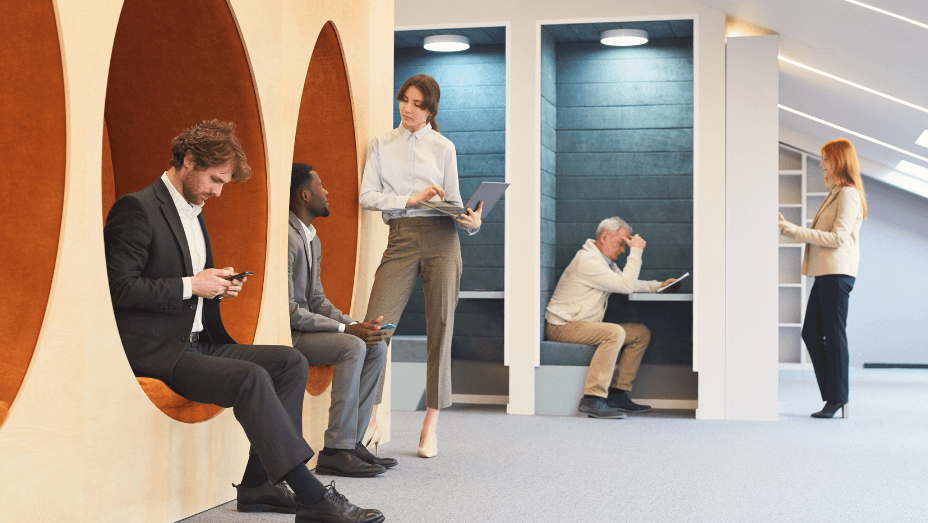No more stuffy office cubicles and rigid schedules! With space-as-a-service (SPaaS) we are changing the way we look at office space, transforming what used to be a traditional workplace into a dynamic, purpose-driven environment that fosters collaboration, creativity and productivity.
But what exactly is space-as-a-service, you ask? Simply put, it's a transformative model that provides fully equipped workspaces on demand, offering flexibility, adaptability and customization to meet the unique needs and objectives of different companies.
With the increase in remote work and flexible schedules in companies, the demand for alternative workplace solutions has risen sharply. Space-as-a-service not only satisfies this growing need, but also offers exciting prospects for companies to thrive.
TL;DR:
- The evolution of office space through Space-as-a-Service (SPaaS) is redefining work environments, moving away from traditional facilities to dynamic, purpose-driven hubs that foster collaboration and productivity.
- SPaaS offers fully equipped, flexible workspaces tailored to the different needs of companies, responding to the increasing demand for remote work and flexible schedules. Companies benefit from the flexibility to expand or downsize their operations without long-term commitments.
- This trend emphasizes employee satisfaction, work-life balance and innovation through shared spaces that encourage networking and the exchange of ideas. Technologies such as Yarooms are streamlining the use of space and supporting this shift towards purpose-driven workspaces that prioritize employee comfort, promote productivity and adapt to modern work dynamics.
- This approach challenges traditional office norms and encourages a paradigm shift in the perception and use of workspaces that enable autonomy, engagement and a culture of purpose among employees.
The Rise of Space-as-a-Service
Today, the space-as-a-service trend is particularly interesting for start-ups and small companies that may not have the resources or desire for a traditional office. The model offers them access to professional workspaces tailored to their exact needs, all without having to spend a lot of money.
But larger companies are also using it more and more, as it gives them the flexibility to expand or downsize their operations as needed! Whether it's a temporary project team or a satellite office in a new market, space-as-a-service offers companies unprecedented flexibility.
Another driving factor behind the rise of this model is the increasing importance of work-life balance and employee satisfaction. Today's employees crave flexibility and autonomy, and space-as-a-service allows employers to fulfill these desires while maintaining high levels of productivity.
In addition, shared workspaces offer professionals from different backgrounds and industries the opportunity to meet, exchange ideas, and network, encouraging innovation and knowledge sharing – and very often leading to unexpected partnerships.

What Is an Example of Space-as-a-Service?
Imagine a bustling city where freelancers, entrepreneurs and small business owners can rent fully equipped workspaces on a flexible basis. They have access to everything they need (e.g. high-speed internet, meeting rooms, printers) without having to sign long-term leases or set up their own offices.
This is exactly what shared offices offer, tailored to the needs of modern professionals who value flexibility and convenience above all else! By offering space as a service, these companies don't just rent out desks, they create vibrant communities where collaboration thrives.
As space-as-a-service grows in popularity, it's important to understand the changing needs of today's workforce and make flexibility a core principle. You might just discover a whole new way of doing business! (Of course, you can still have the space all to yourself – we’re just letting ourselves dream big, that’s all!)
What Does It Mean to Go to the Office Today?
In recent years, the concept of “going to the office” has changed fundamentally. The office is no longer just a place to work, but a dynamic ecosystem that serves as a hub for collaboration, innovation and community, redefining the meaning and purpose behind the act of physically commuting to work.
With technological advances, remote working has become more prevalent and the boundaries between traditional office and home offices are blurring. But even for those who still work at a physical workplace, there has been a shift in thinking. The focus is no longer just on completing tasks, but rather on fostering creativity and collaboration with colleagues.
“Being in an office setting makes it much simpler for me to talk to and get advice from my coworkers on the many different projects we're working on. And because of the regularity and consistency it brings to my day, I am better able to maintain my attention and get things done.” said Jamie Penney, Owner and Operator at MyHomeDwelling
How Space-as-a-Service Brings Attention to Purpose-Driven Workspace
By providing customizable spaces and facilities tailored to support collaborative, innovative and social initiatives, space-as-a-service providers enable companies to create environments that are specifically tailored to the needs of their workforce and foster a purpose-driven culture.
The focus is on making every employee feel as comfortable as possible in an environment where they can do their best work by designing, organizing and managing the space they work in. This new approach challenges traditional notions of office space and redefines the way we look at workplaces today.
"One reason that I choose to go into the office rather than working from home is to be able to use our industrial printer and scanner. There are times when the volume of documents I need to print or scan is either too much for my home printer or in the case of scanning, too time-consuming,” said Mark Pierce, CEO of Cloud Peak Law Group
Empowering Employees in a Flexible Environment
A flexible environment isn't only convenient, but also promotes trust and engagement. By supporting the shift towards purpose-driven workplaces that cater to individual needs and preferences, companies create an environment where employee' professional development and the company's success go hand in hand.
An important aspect of encouraging employees to work in a flexible environment is offering a variety of workspace options. From cozy seating areas for quiet concentration to collaborative areas for brainstorming sessions, everyone should be able to choose the setting that best suits their current task or mood.
Another way to support employees is to use technologies that simplify workplace management. Tools that allow employees to book meeting rooms or find free desks help them avoid unnecessary stress or wasted time searching for suitable workspaces for the day.
However, it's not only important to provide physical flexibility, but also to support employees’ emotional wellbeing and empower them to function at their best. Companies should promote a healthy work-life balance by implementing measures such as remote working or flexible working hours whenever possible.

4 Elements of Purpose-Driven Workspaces
Purpose-driven workspaces take into account not only functional aspects but also sensory, social, and temporal elements. These spaces are designed with intentionality, considering how each element contributes to productivity and overall employee well-being.
Functional
Functionality is key in purpose-driven workspaces. This includes ergonomic furniture and equipment that support healthy posture and movement throughout the day, as well as designated areas for different tasks, such as quiet zones for focused work or common areas for team meetings. In addition, easy access to the necessary tools and resources ensures that employees can do their best work.
Sensory
The sensory aspect of purpose-driven workspaces focuses on creating an environment that appeals to all five senses. Natural light, comfortable temperature control, soothing colors, pleasant scents or the lack of them can all have a strong influence on mood and the ability to concentrate. Incorporating plants or artwork into the space makes it visually interesting while promoting relaxation and creativity.
Social
Social interaction is another important aspect of purpose-driven workspaces. By providing communal areas such as break rooms or communal kitchens that encourage informal interactions that promote teamwork and innovation, and private areas for focused individual work, employees can decide for themselves where they feel most productive.
Temporal
Flexible time management allows employees to balance their personal lives with their professional commitments. By offering options such as remote working or flexible working hours, you can accommodate individual needs while maintaining productivity levels. Plus, allowing employees to choose when and where they work promotes a sense of autonomy, which can boost morale and increase motivation!

How to Design, Organize, and Manage Workspaces That Employees Want to Use
A few simple strategies can make all the difference when it comes to designing, organizing and managing an office space that is truly tailored to the needs and preferences of your employees, e.g:
Understand the Types of Work Environments
Designing, organizing and managing workspaces that employees actually want to use is critical to creating a productive and engaging office environment. To achieve this, it's important to know the different types of work environments your employees need. Some tasks require focused and quiet spaces; others thrive in collaborative environments.
Consider Your Office Layout
In addition to knowing what kinds of working environments you should have, the layout of your office is also key. A well-designed office can optimize workflow and encourage interaction between team members. It's important to find a balance between open areas for collaboration and private areas for concentration.
Offer Flexible Seating Arrangements
Another way to increase employee satisfaction is to offer flexible seating. Not everyone works best at a traditional desk; some prefer standing desks or comfortable lounge areas. When you offer options, everyone can choose what they like best, and that promotes a healthier working style.
Create Both Collaborative and Private Workspaces
Creating both collaborative and private workspaces ensures that employees have access to areas where they can brainstorm ideas together or focus on individual tasks without distraction. This diversity gives employees the opportunity to shape their environment according to their needs.
Leverage Workspace Management Technology
Leveraging workspace management technology can further improve the functionality of the office. The use of tools such as room booking systems or flexible work planning calendars streamlines planning processes and maximizes efficiency in shared spaces.
Yarooms, a leading Workplace Experience Platform, contributes to the concept of space-as-a-service by providing detailed insights into space usage patterns and preferences. One of its key strengths lies in providing flexible space booking capabilities, allowing users to reserve workspaces based on their dynamic needs seamlessly. Whether it's high-speed internet access, state-of-the-art audiovisual equipment, or specialized furniture arrangements, Yarooms ensures that individuals and teams can select spaces that align with their unique preferences and the nature of their tasks.
Furthermore, the platform integrates cutting-edge technology to streamline administrative processes related to space management. From automated check-ins to real-time availability updates and workplace data analytics, it provides a smooth and frictionless experience for facility managers and users. This way, Yarooms Workplace Experience Platform helps create and manage customized, shared spaces and ensures that every square meter is used efficiently.
Involve Employees in the Process
Involving employees in shaping their workplace encourages a sense of ownership and commitment to the company culture. By gathering feedback through surveys or company meetings, you can gain valuable insight into how you can improve the environment based on first-hand experience.
Wrapping Up
The rise of space-as-a-service has revolutionized the way we look at traditional office spaces and has opened up new opportunities for companies to create purpose-driven workspaces that support their employees and promote productivity.
By providing flexible working environments, space-as-a-service allows everyone to decide for themselves where and how they work, freeing them from the constraints of the fixed desk. Of course, it's not just about the physical infrastructure, but an entire ecosystem that promotes wellbeing, engagement and productivity.
With this innovative approach to office space, companies can create environments where people feel inspired to do their best work. If you’ve already tried it, we’re curious to hear about your experience!












